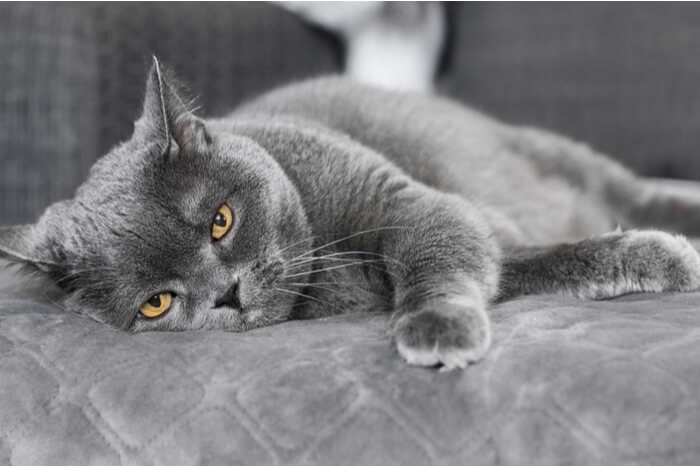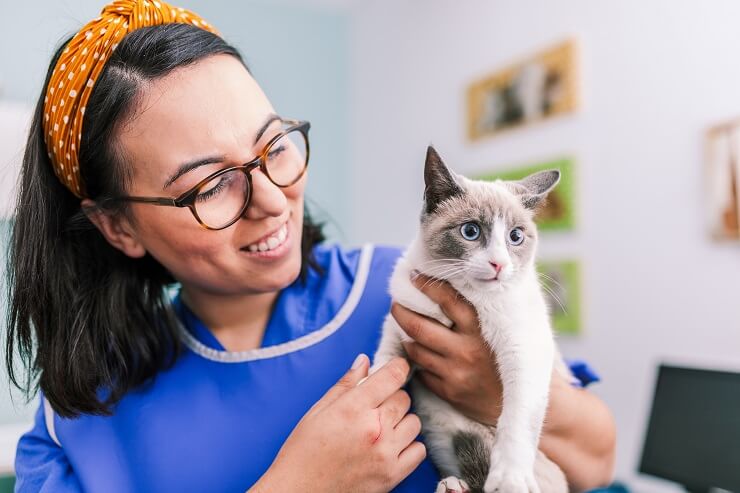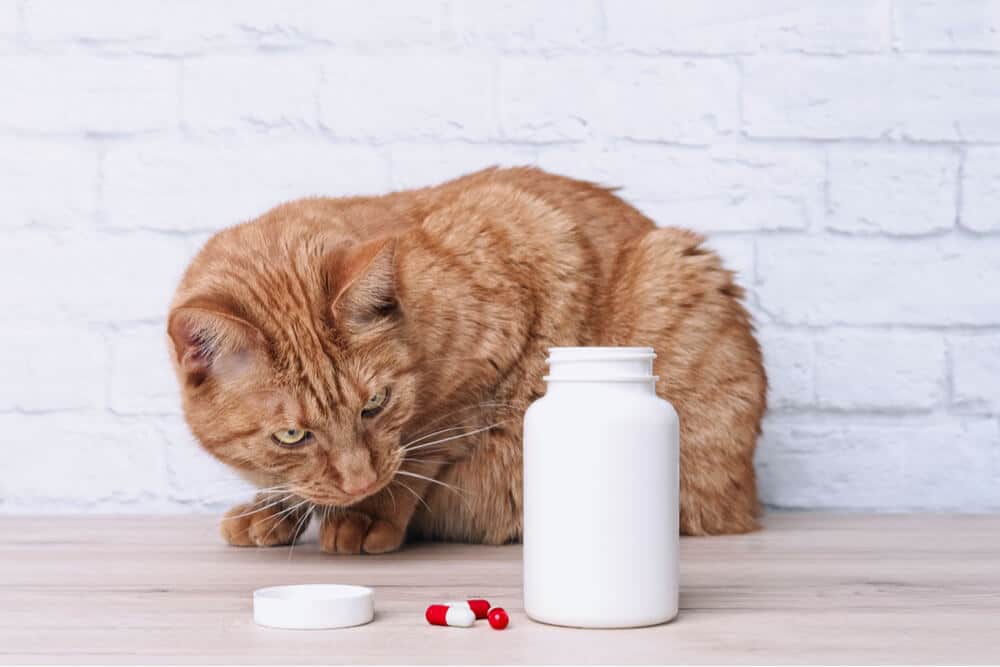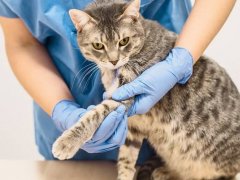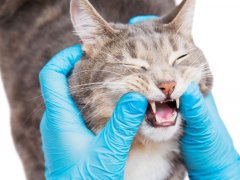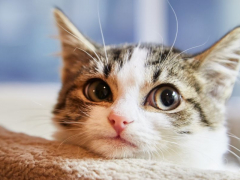The aim of this article is to provide a good quality, accurate, easily understandable summary of the details about insecticide poisoning, with a particular focus on the risk of toxicity in cats.
Quick Overview: Insecticide Poisoning in Cats





About Insecticide Poisoning in Cats
Pesticides, by definition, are substances that are used to kill pests.
Insecticides are a sub-group of pesticides, and by definition, they are substances that are used to kill insects. Insecticides have may uses, including pest control around the home, in the garden, and even directly on dogs and cats, in the form of products to control fleas, as well as other types of external parasite control such as tick treatments. Sometimes toxic products are deliberately applied to cats by owners who do not realise the risk of poisoning, but accidental exposure to insecticides is more common.
There are many other types of toxic substances that can affect cats, including herbicides (substances that kill plants, commonly known as weedkillers), rodenticides (substances that kill rodent pests) and antifreeze.
Insecticides cause a specific life threatening type of toxicosis that all pet owners should know about.
While poisoning is unlikely to happen if products are used according to manufacturers’ recommendations, mishaps can happen, and it’s common for cats to become ill and even to die following exposure to insecticides. Exposure may happen via ingestion (e.g. licking spills, or self-grooming chemicals from their own coats) or via absorption (e.g. if a dog spot-on product is applied to a cat).
What Are the Different Types of Insecticides?
Insecticides work in different ways, requiring different specific approaches. The most common insecticides are:
- Anticholinesterase Insecticides (organophosphates (OPs) and the carbamates),
- Pyrethrins
- Amitraz
Symptoms of Insecticide Poisoning in Cats
The symptoms shown by cats depend on the type of insecticide that they have been exposed to, and they are a consequence of the specific mechanism of action of each agent.
Anticholinesterase Insecticides
These substances (e.g. organophosphates and carbamates) bind to and inhibit cholinesterase, which is an enzyme present in synapses (the connection points between nerves), They “take out” acetylcholinesterase, leading to an accumulation of acetylcholine (a neurotransmitter) at the junction between the nerve junction, which in turn leads to over-stimulation of the target that is being stimulated by the nerve (e.g. a muscle).
Organophosphates have a stronger and more permanent effect than carbamates but the signs shown by poisoned animals are the same. Examples of well known organophosphates (OPs) include:
- Malathion, which is used for mosquito and fruitfly control
- Chlorpyrifos, which is used for crops, as well as in buildings and other settings
- Diazinon which may be used in buildings to control infestations of cockroaches, silverfish, ants, and fleas.
- Disulfoton which has been used for pest control in fields of vegetables and crops.
- Tetrachlorvinphos which has been used in the past to control fleas and ticks
Clinical signs of poisoning include anorexia, salivation (drooling), lacrimation (excessive tear production), diarrhea, abdominal cramps and discomfort, bradycardia (a slow heart rate), miosis (constricted pupils), frequent urination, respiratory signs (difficulty breathing caused by narrowing of the airways and excessive respiratory secretions), as well as muscle tremors and seizures. If left untreated, death can follow, caused by excessive respiratory secretions and/or seizures.
Pyrethrins
Pyrethrins are a natural substance derived from Chrysanthemum flowers, while pyrethroids are artificially produced synthetic analogues. They act by affecting the sodium channels in cell membranes, leading to prolonged depolarization (stimulation) of nervous tissue.
Most products that are commonly used contain only low levels of pyrethroids, making them toxic to insects but safe for mammals. However spot-on type flea products, containing 45-65% permethrin, are typically used for flea control in dogs, and although they are clearly labelled for this purpose, they are commonly applied by owners to cats, leading to severe signs of poisoning.
There are several different formulations of products that may contain pyrethrins and it always makes sense to read the label before using any product in a house where there are cats.
Signs of toxicity include anorexia, salivation/drooling, agitation and restlessness, vomiting, incoordination, staggering when trying to jump, walk or even just to stand normally, as well as twitching and trembling. In severe cases, there is a risk of death.
Amitraz
Amitraz is an alpha-adrenergic agonist which is used in agriculture, as well as being used to control ticks and Demodex mites in dogs. Poisoning is rare in cats, but again, use of a dog-specific product in a cat will cause severe toxicity, or if a cat has close contact with a dog that has been treated with amitraz (e.g. sleeping with a dog wearing an amitraz flea collar) this can cause poisoning.
Signs of poisoning include anorexia, dullness, weakness, incoordination, vomiting, diarrhea, slow heart rate, low body temperature, and potentially death.
Diagnosis of Insecticide Poisoning in Cats
Often, there will be a history of known insecticide exposure (e.g. application of a dog flea spot-on product to a cat) where the hazard has been identified. In other cases, a cat may present with signs that are suspicious, and the vet may need to go through a process of making an accurate diagnosis. Contact with the animal poison control centre or the ASPCA poison advice library may be needed to confirm certain details.
Detailed History Taking
Your DVM veterinarian will discuss every aspect of your cat’s life, looking for clues that may include possible exposure to a source of insecticide. Young animals and small animals may be more prone to insecticide poisoning than older, larger cats.
Physical Examination
Your veterinarian will check your cat over carefully, ruling out other causes of the signs that are being shown. A detailed neurological examination will be carried out.
Routine Blood Tests and Other Laboratory Work
Your veterinarian may suggest blood tests, including the usual panel of diagnostic tests, such as hematology (complete blood count) and biochemistry profiles, to confirm that there is no other underlying illness affecting your cat.
Urinalysis may also be carried out.
Specialised Tests
The measurement of acetyl choline esterase (ChE) activity in the blood, brain, or retina may be carried out by an external laboratory as a specific diagnostic tool that can be quick and inexpensive.
How to Treat Insecticide Poisoning in Cats
The priority initially is to stabilise any general signs of insecticide poisoning and then proceed with the specific treatment.
General treatment
The priority initially is to stabilise any general signs of insecticide poisoning:
- Supporting respiration for cats that are having breathing difficulties
- Anti-seizure medication for a cat that is having seizures
- Anti-emetic treatment to stop vomiting
- Intravenous fluids as general support.
Specific treatment to remove insecticide from the body is often also carried out, to prevent further absorption, with the details depending on the suspected cause.
- Following oral toxicity, vomiting may be induced, gastric lavage may be carried out, activated charcoal may be given, and enemas may be adminstered.
- Following dermal exposure, a cat may be washed in detergent to remove all traces of insecticide.
Specific treatment
As well as the above, specific treatment may be given which depends on the type of insecticide.
Anticholinesterase Insecticides (Organophosphates and Carbamates)
Some of the signs of poisoning (so-called muscarinic signs) can be controlled with atropine sulfate, but atropine does not control other signs (e.g. the nicotinic or central nervous system signs).
The ideal therapy is pralidoxime chloride (2-PAM), which regenerates acetyl choline esterase by allowing its release from the organophosphate. However this needs to be given at an early stage, as if the organophosphate changes have “aged”, the acetyl choline esterase is permanently attached, and cannot be released.
Intravenous lipid emulsions (ILE) may be suggested as a type of treatment.
Pyrethrins
The signs of pyrethrin toxicity may be controlled using methocarbamol, a muscle relaxant that’s normally used to treat medical conditions that cause acute, painful musculoskeletal spasms. Intravenous lipid emulsions (ILE) have been used successfully in cats with permethrin toxicosis
Amitraz
A specific drug called yohimbine may be given intravenously to reverse the signs of toxicity. Alternatively, atipamezole (an antidote to sedation that’s in common use in most veterinary clinics) may be administered.
Prognosis
The prognosis depends on the severity of the signs, and the level of insecticide exposure.
Prevention of Insecticide Poisoning in Cat
Causes of poisoning in cats are wide-ranging, including the ingestion of human medications.
All insecticides should be used strictly according to the manufacturer’s instructions, and they should be kept out of the reach of cats. Dog parasite control products should never be applied to cats.
Conclusion
insecticide poisoning is a specific diagnosis linked to exposure to insecticide. Once the problem has been identified, general supportive treatment, as well as treatment that’s specific to the type of insecticide, can be given.
Frequently Asked Questions
What are the symptoms of insecticide poisoning in cats?
The signs are often non specific, but they often include respiratory, gastrointestinal and neurological signs.
Can cats die from insecticide poisoning?
In severe cases of insecticide poisoning, death is possible, and prompt treatment of poisoned cats is essential.
How long does it take to get insecticide poisoning?
Exposure to high levels of insecticide, or even low levels of certain types of insecticide, can cause rapid signs of toxicity.
How does insecticide affect pets?
Insecticides generally affect the biological chemistry of the nerve-nerve and nerve-muscle junctions, causing a wide range of signs of toxicity.
Are humans at risk from insecticide poisoning?
Humans are less at risk compared to cats, as they are smaller, with particularly sensitive metabolisms. However, insecticides do present a risk to all species, which is why it is so important to adhere to manufacturer's recommendations on how they are used. In particular, the use of personal protective equipment for humans is important.
